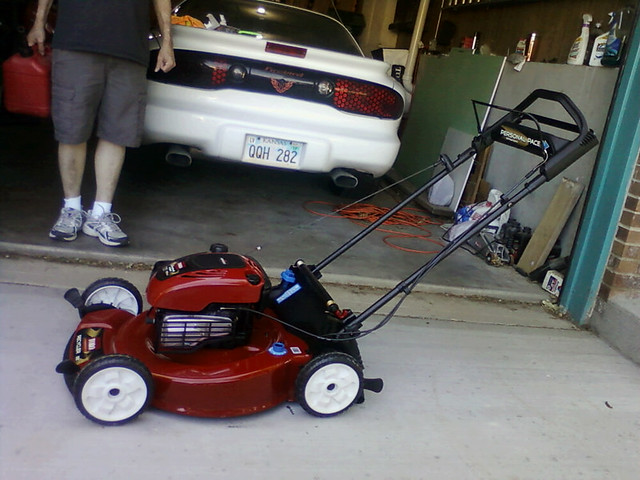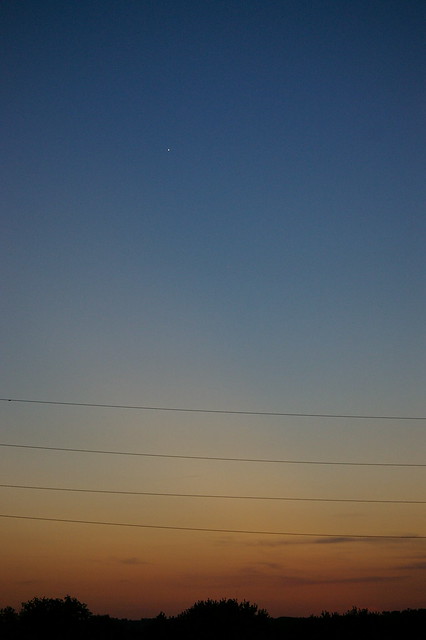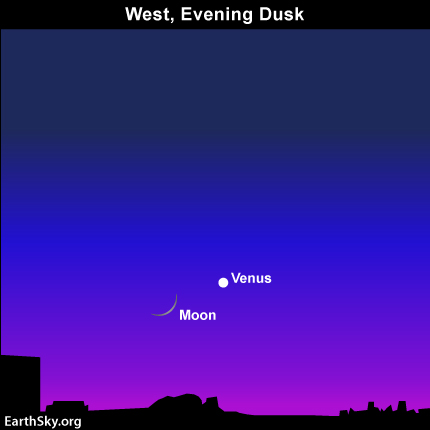Monday afternoon I returned home from work all psyched up and ready to catch a glimpse of the new moon, the baby one, the one that’s barely twenty-four hours old. I kept one eye on the sky all day, getting a bit perturbed at it’s pristine blueness compared to yesterday’s puffy whiteness competing with the solar eclipse. I muttered to myself on the drive home, but immediately became distracted when I pulled in the driveway to find my husband inserting a new headlamp light blub in the Bonneville. I asked him to replace it because I discovered on my midnight ride home from Powell Observatory Saturday that my left one had burnt out.
As I entered the garage, Terry stopped at the garage door and looked at me expectantly. I raised my left eyebrow in my classic Spock impersonation and gazed around trying to discern what I missed. My eyes fell on the area of the second garage bay where we store the lawnmower. I gasped in surprise as I spied a brand new shiny red pushmower.


Any thoughts of moon catching fled from my brain. The mower begged to be test driven (literally since it’s a self-propelled model). I spent a half hour acquainting myself with the mower in the backyard. Despire popping a couple of wheelies, I liked the way the new mower conquered the grass and the terrain.
My mind got back on track with my moon hunt as eight o’clock approached. I asked Rachelle if she wanted to accompany me to my observing site, ostensibly to get Apollo out of the house on a short walk as well. She agreed readily. I grabbed the camera gear and tripod and placed them in the trunk, while Rachelle let Apollo jump in the back seat of the Bonneville.
I remembered to check the time of sunset for Monday evening (8:30 p.m.) but forgot to confirm the time of moonset. I later learned (upon returning home to my laptop) that moonset occurred shortly after 9:20 p.m. Since I rushed my daughter out of the house, she left her smartphone there. She has a nifty app that functions as an interactive ‘live’ star atlas and would have helped me locate the baby moon playing peekaboo behind the clouds.

I setup the camera and tripod and took over seventy photos of the sunset and twilight in the vain hope that even if I couldn’t find the baby moon with my naked eye, I might capture it ‘on film’ and find it later when I download the photos from the camera. I stayed until nine o’clock, not knowing I still had twenty more minutes to try to find the moon, as the twilight faded away and Venus continued to brighten. My daughter convinced me the haze and few wispy clouds clinging to the western horizon obscured the moon, preventing me from seeing it’s slim sliver of a crescent.
I waited until Tuesday morning to download the photos and review them. Try as I might, I could not find the crescent moon. I even verified the location of the moon in relation to the sun and Venus for the time period I observed Monday evening. I still feel I should have been able to find it, but perhaps it was the haze, thin clouds and lingering twilight that thwarted my efforts.
I snagged a few (more than a few actually, but I won’t inundated you with them) photos of the sunset, which continued to glow bright pink, orange and purple thirty minutes after the sun dipped below the horizon.
 This evening I plan to return to the same site to capture the two-day old crescent moon as it passes Venus. According to Earthysky, tonight is the last time this year (2012) to see the moon and Venus so close to each other. Venus rapidly descends over the next two weeks as it rushes to cut between us (Earth) and the sun (the year’s most popular astronomical event – the Transit of Venus).
This evening I plan to return to the same site to capture the two-day old crescent moon as it passes Venus. According to Earthysky, tonight is the last time this year (2012) to see the moon and Venus so close to each other. Venus rapidly descends over the next two weeks as it rushes to cut between us (Earth) and the sun (the year’s most popular astronomical event – the Transit of Venus).
∞ ∞ ∞
The following information was compiled by the Astronomical Society of Kansas City (ASKC):
Transit of Venus FAQ
What is the transit of Venus?
Once in a great while, Venus can pass directly between the Sun and Earth. Only the planets Mercury and Venus can do this, since they are the only two planets closer to the Sun than Earth. When they do, they appear as small black dots crossing the face of the Sun over a period of several hours.
When is the transit of Venus?
From the Kansas City area, it will begin at 5:09 PM CDT on Tuesday, June 5th, and continue until sunset, which will be around 8:41 PM. Weather permitting, we will see 53% of the entire transit before sunset.
Why is the transit of Venus such a special event?
Because of the size and slightly different tilt of the orbits of Venus and Earth, a transit does not happen every time Venus passes between the Sun and Earth; it’s almost always “above” or “below” the Sun when it reaches what is called inferior conjunction. In a 243-year cycle, there are only 4 transits. They occur at very uneven intervals – the last one was in June of 2004, but the next one isn’t until December of 2117, 105 ½ years from now!
Historically, timings of transits of Venus were carried out in the 17th, 18th, and 19th centuries to trigonometrically calculate the size of the orbit of Venus, which when applied to Kepler’s 3rd law of planetary motion, determined the absolute (rather than relative) size of every other orbit in the Solar System. This was actually the best way to measure distances in the Solar System until radar and space probes became available in the latter half of the 20th century.
How can I observe the transit of Venus?
You can make a pinhole projector with a couple of pieces of card stock or a small cardboard box; just poke a small hole in one of the pieces or one end of the box, and position it such that it casts a small image of the Sun on the other piece or the other end of the box.
It will be a lot easier to see, though, through a suitable filter, either with your unaided eye or binoculars or a telescope completely covered by a full-aperture filter. Safe filters are available at HMS Beagle, a science store at English Landing in Parkville.
Where will there be organized viewing of the transit of Venus?
There will be at least 3 organized events in the Kansas City area:
- The Astronomical Society of Kansas City will open Powell Observatory in Louisburg. A map and directions are at http://askc.org/images/powell_map.jpg.
- The ASKC will also open Warkoczewski Observatory at UMKC, on the roof of Royall Hall. Park on the 4th level of the parking structure on the southwest corner of 52nd & Rockhill and take the skywalk into Royall, then up 2 flights of stairs to the roof.
- Kansas Citizens for Science, with assistance from ASKC members, will host observing from the rooftop of Coach’s Bar & Grill, 9089 W. 135th, Overland Park.

